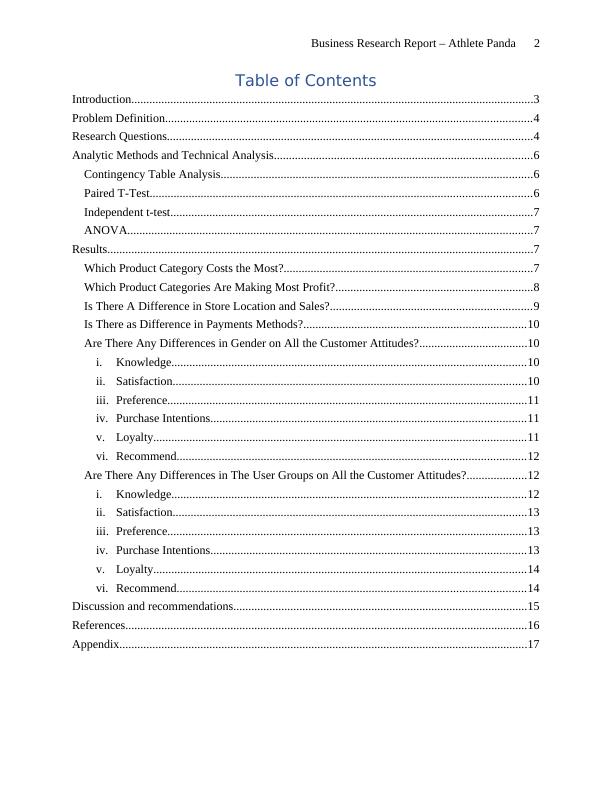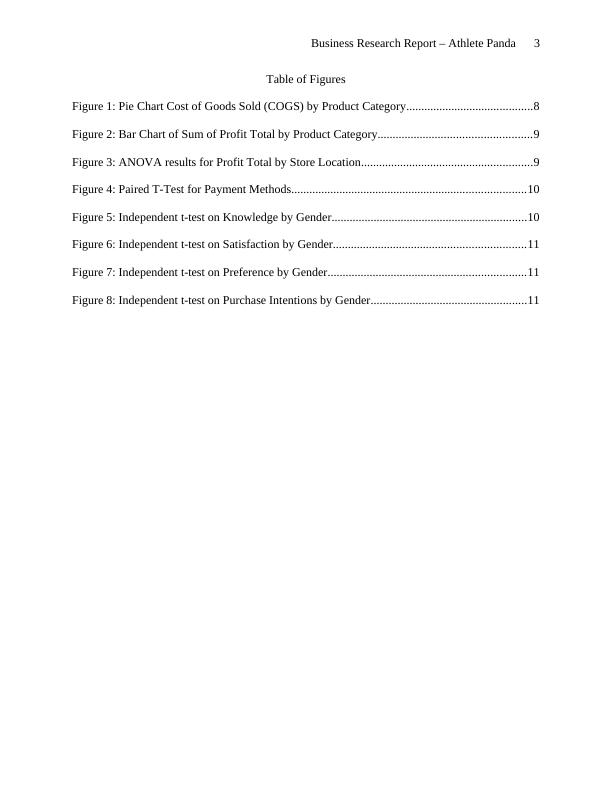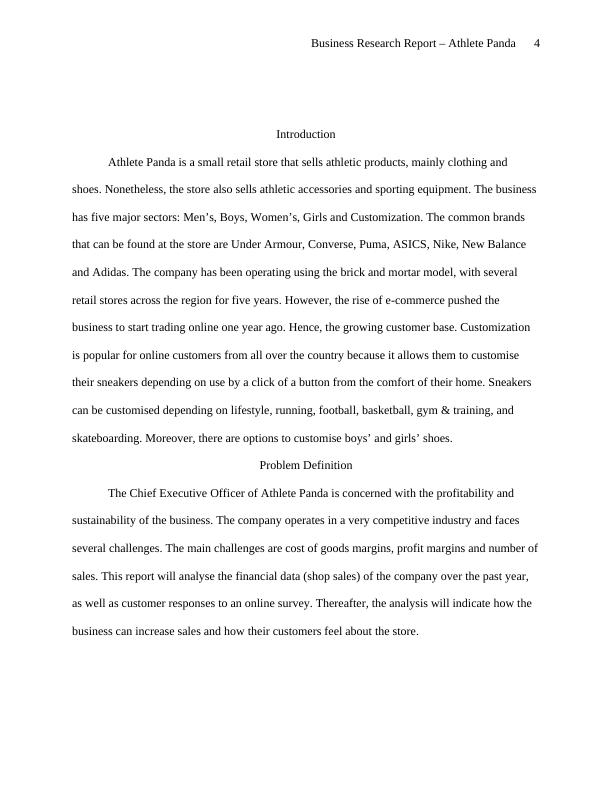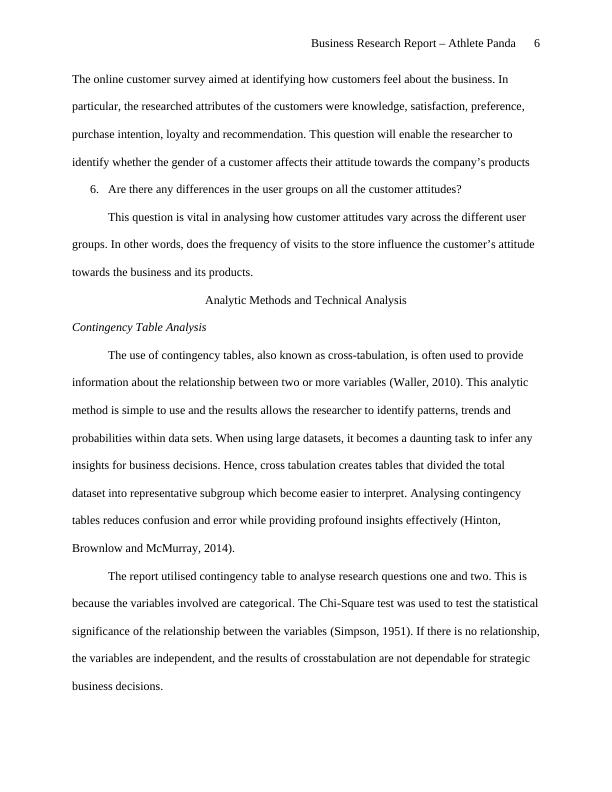Athlete Panda: Business Research Report
Creating a business report for the CEO of a retail company called Athlete Panda based on fictional data.
21 Pages2679 Words133 Views
Added on 2023-06-04
About This Document
This business research report analyses the financial data and customer responses of Athlete Panda, a small retail store that sells athletic products. The report addresses the challenges faced by the company, including profit margins, cost of products sold, and sales. The report uses contingency table analysis, paired t-test, independent t-test, and ANOVA to answer research questions related to product categories, store location, payment methods, and customer attitudes. The report recommends that the company focus on men's shoes and women's clothing, consider online sales, and improve customer knowledge and preference.
Athlete Panda: Business Research Report
Creating a business report for the CEO of a retail company called Athlete Panda based on fictional data.
Added on 2023-06-04
ShareRelated Documents
Business Research Report – Athlete Panda 1
Business Research Report – Athlete Panda
By Student’s Name
Student’s Number
BUS501 - Business Analytics and Statistics
Tutor’s Name
Name of the University
Date
Word Count:
Business Research Report – Athlete Panda
By Student’s Name
Student’s Number
BUS501 - Business Analytics and Statistics
Tutor’s Name
Name of the University
Date
Word Count:

Business Research Report – Athlete Panda 2
Table of Contents
Introduction......................................................................................................................................3
Problem Definition..........................................................................................................................4
Research Questions..........................................................................................................................4
Analytic Methods and Technical Analysis......................................................................................6
Contingency Table Analysis........................................................................................................6
Paired T-Test...............................................................................................................................6
Independent t-test.........................................................................................................................7
ANOVA.......................................................................................................................................7
Results..............................................................................................................................................7
Which Product Category Costs the Most?...................................................................................7
Which Product Categories Are Making Most Profit?..................................................................8
Is There A Difference in Store Location and Sales?...................................................................9
Is There as Difference in Payments Methods?..........................................................................10
Are There Any Differences in Gender on All the Customer Attitudes?....................................10
i. Knowledge......................................................................................................................10
ii. Satisfaction......................................................................................................................10
iii. Preference........................................................................................................................11
iv. Purchase Intentions.........................................................................................................11
v. Loyalty............................................................................................................................11
vi. Recommend....................................................................................................................12
Are There Any Differences in The User Groups on All the Customer Attitudes?....................12
i. Knowledge......................................................................................................................12
ii. Satisfaction......................................................................................................................13
iii. Preference........................................................................................................................13
iv. Purchase Intentions.........................................................................................................13
v. Loyalty............................................................................................................................14
vi. Recommend....................................................................................................................14
Discussion and recommendations..................................................................................................15
References......................................................................................................................................16
Appendix........................................................................................................................................17
Table of Contents
Introduction......................................................................................................................................3
Problem Definition..........................................................................................................................4
Research Questions..........................................................................................................................4
Analytic Methods and Technical Analysis......................................................................................6
Contingency Table Analysis........................................................................................................6
Paired T-Test...............................................................................................................................6
Independent t-test.........................................................................................................................7
ANOVA.......................................................................................................................................7
Results..............................................................................................................................................7
Which Product Category Costs the Most?...................................................................................7
Which Product Categories Are Making Most Profit?..................................................................8
Is There A Difference in Store Location and Sales?...................................................................9
Is There as Difference in Payments Methods?..........................................................................10
Are There Any Differences in Gender on All the Customer Attitudes?....................................10
i. Knowledge......................................................................................................................10
ii. Satisfaction......................................................................................................................10
iii. Preference........................................................................................................................11
iv. Purchase Intentions.........................................................................................................11
v. Loyalty............................................................................................................................11
vi. Recommend....................................................................................................................12
Are There Any Differences in The User Groups on All the Customer Attitudes?....................12
i. Knowledge......................................................................................................................12
ii. Satisfaction......................................................................................................................13
iii. Preference........................................................................................................................13
iv. Purchase Intentions.........................................................................................................13
v. Loyalty............................................................................................................................14
vi. Recommend....................................................................................................................14
Discussion and recommendations..................................................................................................15
References......................................................................................................................................16
Appendix........................................................................................................................................17

Business Research Report – Athlete Panda 3
Table of Figures
Figure 1: Pie Chart Cost of Goods Sold (COGS) by Product Category..........................................8
Figure 2: Bar Chart of Sum of Profit Total by Product Category...................................................9
Figure 3: ANOVA results for Profit Total by Store Location.........................................................9
Figure 4: Paired T-Test for Payment Methods..............................................................................10
Figure 5: Independent t-test on Knowledge by Gender.................................................................10
Figure 6: Independent t-test on Satisfaction by Gender................................................................11
Figure 7: Independent t-test on Preference by Gender..................................................................11
Figure 8: Independent t-test on Purchase Intentions by Gender....................................................11
Table of Figures
Figure 1: Pie Chart Cost of Goods Sold (COGS) by Product Category..........................................8
Figure 2: Bar Chart of Sum of Profit Total by Product Category...................................................9
Figure 3: ANOVA results for Profit Total by Store Location.........................................................9
Figure 4: Paired T-Test for Payment Methods..............................................................................10
Figure 5: Independent t-test on Knowledge by Gender.................................................................10
Figure 6: Independent t-test on Satisfaction by Gender................................................................11
Figure 7: Independent t-test on Preference by Gender..................................................................11
Figure 8: Independent t-test on Purchase Intentions by Gender....................................................11

Business Research Report – Athlete Panda 4
Introduction
Athlete Panda is a small retail store that sells athletic products, mainly clothing and
shoes. Nonetheless, the store also sells athletic accessories and sporting equipment. The business
has five major sectors: Men’s, Boys, Women’s, Girls and Customization. The common brands
that can be found at the store are Under Armour, Converse, Puma, ASICS, Nike, New Balance
and Adidas. The company has been operating using the brick and mortar model, with several
retail stores across the region for five years. However, the rise of e-commerce pushed the
business to start trading online one year ago. Hence, the growing customer base. Customization
is popular for online customers from all over the country because it allows them to customise
their sneakers depending on use by a click of a button from the comfort of their home. Sneakers
can be customised depending on lifestyle, running, football, basketball, gym & training, and
skateboarding. Moreover, there are options to customise boys’ and girls’ shoes.
Problem Definition
The Chief Executive Officer of Athlete Panda is concerned with the profitability and
sustainability of the business. The company operates in a very competitive industry and faces
several challenges. The main challenges are cost of goods margins, profit margins and number of
sales. This report will analyse the financial data (shop sales) of the company over the past year,
as well as customer responses to an online survey. Thereafter, the analysis will indicate how the
business can increase sales and how their customers feel about the store.
Introduction
Athlete Panda is a small retail store that sells athletic products, mainly clothing and
shoes. Nonetheless, the store also sells athletic accessories and sporting equipment. The business
has five major sectors: Men’s, Boys, Women’s, Girls and Customization. The common brands
that can be found at the store are Under Armour, Converse, Puma, ASICS, Nike, New Balance
and Adidas. The company has been operating using the brick and mortar model, with several
retail stores across the region for five years. However, the rise of e-commerce pushed the
business to start trading online one year ago. Hence, the growing customer base. Customization
is popular for online customers from all over the country because it allows them to customise
their sneakers depending on use by a click of a button from the comfort of their home. Sneakers
can be customised depending on lifestyle, running, football, basketball, gym & training, and
skateboarding. Moreover, there are options to customise boys’ and girls’ shoes.
Problem Definition
The Chief Executive Officer of Athlete Panda is concerned with the profitability and
sustainability of the business. The company operates in a very competitive industry and faces
several challenges. The main challenges are cost of goods margins, profit margins and number of
sales. This report will analyse the financial data (shop sales) of the company over the past year,
as well as customer responses to an online survey. Thereafter, the analysis will indicate how the
business can increase sales and how their customers feel about the store.

Business Research Report – Athlete Panda 5
Research Questions
The challenges stated by the company’s management are the basis of the report’s
research questions. Therefore, critically analyse the business of Athlete Panda, the following
research questions were used.
1. Which product category costs the most?
The report uses this question to clarify which product category incurs the most cost.
Hence, the business will be to analyse how the product category affects the profitability of the
store.
2. Which product categories are making most profit?
One of the main challenges for the company’s management is making good profit. This
question will help the research identify which product category brings in more revenue for the
business.
3. Is there a difference in store location and sales?
It is important too understand how the sales of the business are affected by the location of
the store. Generally, a physical store at the front of a busy street is expected to attract more
customers, hence should have higher sales. This question also allows the research to analyse
whether trading online is beneficial to the business.
4. Is there as difference in payments methods?
The company offers its customers two option to pay for their products; cash or credit
card. This question allows the research to analyse which payment method is popular among the
customers. Hence, the business can plan its finances more effectively.
5. Are there any differences in gender on all the customer attitudes?
Research Questions
The challenges stated by the company’s management are the basis of the report’s
research questions. Therefore, critically analyse the business of Athlete Panda, the following
research questions were used.
1. Which product category costs the most?
The report uses this question to clarify which product category incurs the most cost.
Hence, the business will be to analyse how the product category affects the profitability of the
store.
2. Which product categories are making most profit?
One of the main challenges for the company’s management is making good profit. This
question will help the research identify which product category brings in more revenue for the
business.
3. Is there a difference in store location and sales?
It is important too understand how the sales of the business are affected by the location of
the store. Generally, a physical store at the front of a busy street is expected to attract more
customers, hence should have higher sales. This question also allows the research to analyse
whether trading online is beneficial to the business.
4. Is there as difference in payments methods?
The company offers its customers two option to pay for their products; cash or credit
card. This question allows the research to analyse which payment method is popular among the
customers. Hence, the business can plan its finances more effectively.
5. Are there any differences in gender on all the customer attitudes?

Business Research Report – Athlete Panda 6
The online customer survey aimed at identifying how customers feel about the business. In
particular, the researched attributes of the customers were knowledge, satisfaction, preference,
purchase intention, loyalty and recommendation. This question will enable the researcher to
identify whether the gender of a customer affects their attitude towards the company’s products
6. Are there any differences in the user groups on all the customer attitudes?
This question is vital in analysing how customer attitudes vary across the different user
groups. In other words, does the frequency of visits to the store influence the customer’s attitude
towards the business and its products.
Analytic Methods and Technical Analysis
Contingency Table Analysis
The use of contingency tables, also known as cross-tabulation, is often used to provide
information about the relationship between two or more variables (Waller, 2010). This analytic
method is simple to use and the results allows the researcher to identify patterns, trends and
probabilities within data sets. When using large datasets, it becomes a daunting task to infer any
insights for business decisions. Hence, cross tabulation creates tables that divided the total
dataset into representative subgroup which become easier to interpret. Analysing contingency
tables reduces confusion and error while providing profound insights effectively (Hinton,
Brownlow and McMurray, 2014).
The report utilised contingency table to analyse research questions one and two. This is
because the variables involved are categorical. The Chi-Square test was used to test the statistical
significance of the relationship between the variables (Simpson, 1951). If there is no relationship,
the variables are independent, and the results of crosstabulation are not dependable for strategic
business decisions.
The online customer survey aimed at identifying how customers feel about the business. In
particular, the researched attributes of the customers were knowledge, satisfaction, preference,
purchase intention, loyalty and recommendation. This question will enable the researcher to
identify whether the gender of a customer affects their attitude towards the company’s products
6. Are there any differences in the user groups on all the customer attitudes?
This question is vital in analysing how customer attitudes vary across the different user
groups. In other words, does the frequency of visits to the store influence the customer’s attitude
towards the business and its products.
Analytic Methods and Technical Analysis
Contingency Table Analysis
The use of contingency tables, also known as cross-tabulation, is often used to provide
information about the relationship between two or more variables (Waller, 2010). This analytic
method is simple to use and the results allows the researcher to identify patterns, trends and
probabilities within data sets. When using large datasets, it becomes a daunting task to infer any
insights for business decisions. Hence, cross tabulation creates tables that divided the total
dataset into representative subgroup which become easier to interpret. Analysing contingency
tables reduces confusion and error while providing profound insights effectively (Hinton,
Brownlow and McMurray, 2014).
The report utilised contingency table to analyse research questions one and two. This is
because the variables involved are categorical. The Chi-Square test was used to test the statistical
significance of the relationship between the variables (Simpson, 1951). If there is no relationship,
the variables are independent, and the results of crosstabulation are not dependable for strategic
business decisions.

End of preview
Want to access all the pages? Upload your documents or become a member.
Related Documents
Analysis of Retail Surge's Product Categories: Profit, COGS, Payment Methods, and Customer Attitudes | Deskliblg...
|26
|4312
|494
Analysis of Retail Surge Company's Market Research Datalg...
|26
|4747
|387
Customer Attribute and Profit Report Analysis for Nikelg...
|29
|3050
|109
Business Statistics: Analysis and Results for Retail Surgelg...
|28
|5646
|421
Analysis of Customer Data for Retail Surge: Business Statisticslg...
|27
|5018
|427
Profit Analysis with Customer Satisfaction for Nikelg...
|29
|4014
|250
